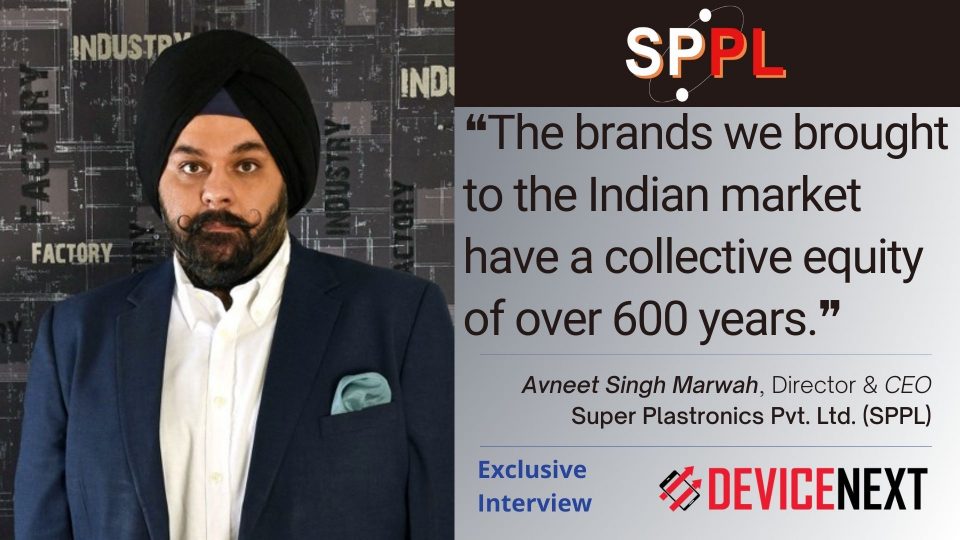With a rich history spanning over 30 years, Super Plastronics Pvt. Ltd. (SPPL), a leading manufacturing company specializing in consumer electronics, has brought renowned global brands to the Indian market, including Kodak, Thomson, Blaupunkt, Westinghouse, and White-Westinghouse. In this exclusive interview, we have the privilege of speaking with Mr. Avneet Singh Marwah, Director and CEO of SPPL. He shares insights into SPPL’s journey, emphasizing the significance of securing these brand licenses and the challenges encountered along the way. Additionally, he sheds light on SPPL’s market expansion plans, particularly in the booming appliance sector, as well as their recent shift to a new state-of-the-art facility in Pilkhua. Furthermore, he provided valuable observations on the challenges faced by Indian manufacturers in their quest to establish a global presence.
To view the video, click here.
Here’s an excerpt from the interaction:
Can you provide an overview of SPPL’s journey and the global brands it has introduced to the Indian market?
SPPL takes pride in being a brand licensee for several renowned global brands. We have brought Kodak and Thomson televisions, along with the legendary sound brand Blaupunkt from Germany, which has a global presence. Additionally, we have partnered with Westinghouse, a well-known American television brand, and White-Westinghouse appliances from the House of Electrolux. Our journey has been fantastic over the past 30 years. We started with plastic molding and gradually expanded into manufacturing black and white televisions, color televisions, and LCDs. Today, we stand as one of India’s leading manufacturers of LED Smart TVs. Licensing these brands was no easy task. These brands have a collective equity of over 600 years, and it took considerable effort, sometimes spanning a year or two, to convince and secure these partnerships. I remember personally flying to Paris for just a couple of hours to address Thompson’s concerns about the Indian market. That should give you an idea of the dedication and effort involved in securing these global brand licenses.
Could you share your plans for market expansion and the relocation to your new plant in Pilkhua, near Hapur?
One of our primary focuses is on appliances. Over the past two years, there has been significant market penetration for products like air conditioners, washing machines, and air coolers in India. Recognizing this trend, our company has made substantial investments in the new plant, which we recently inaugurated. SPPL is now one of the few brands engaged in backend manufacturing. We will be introducing 72 new washing machine models across the next two quarters, covering semi-automatic, fully automatic top load, and front load machines. We aim to be among the top three online brands and the top five brands overall in the next four years. To support our growth, we have planned to shift to a larger facility. The new facility in Pilkhua, near Hapur, is strategically located on a highway, providing connectivity to more than 12 national and state highways, including the Delhi-Mumbai highway. This excellent connectivity will result in significant fuel and time savings. With this new plant, our target is to produce over 2 million units of televisions.
What consumer and market trends are you observing that will shape the electronics market in the upcoming year?
Last year, we introduced QLED televisions, and it was an eye-opening experience. We always focus on new technology televisions as Kodak and other smart TV brand, with Google Android being our partner. When we launched QLEDs, we stocked for around 30 to 45 days, but they sold out within six hours. This revealed the strength of these brands and how Indian consumers are evolving, seeking premium yet affordable options. Customers are willing to upgrade their television screen size within the same price range. Based on this learning, we plan to launch more technology-driven televisions this year and increase screen sizes. Similarly, in the appliances segment, we are emphasizing smart home solutions, including front load Wash Dry machines with capacities of 10.5, 6.5, and 7.5, and we recently launched a 2-ton air conditioner. We are also planning to introduce 100-liter air coolers. Overall, there is a trend towards upgrading across various product categories.
From your perspective, what challenges do Indian manufacturers face when expanding globally?
The Indian market is not primarily export-centric compared to our neighboring countries. The industry lacks the exposure needed for successful exports. However, we have recently ventured into Latin America and have initiated conversations with several countries across the globe. Since obtaining the Google Android license, we have received numerous queries and witnessed growing brand presence. All five of our licensed brands already have a presence in over 120 countries, and we have received interest from around 25 to 30 countries looking to do business with India. In the next two years, we plan to start exporting our products and establish a strong foothold in international markets as we are committed to a long-term growth as a brand in other countries.




